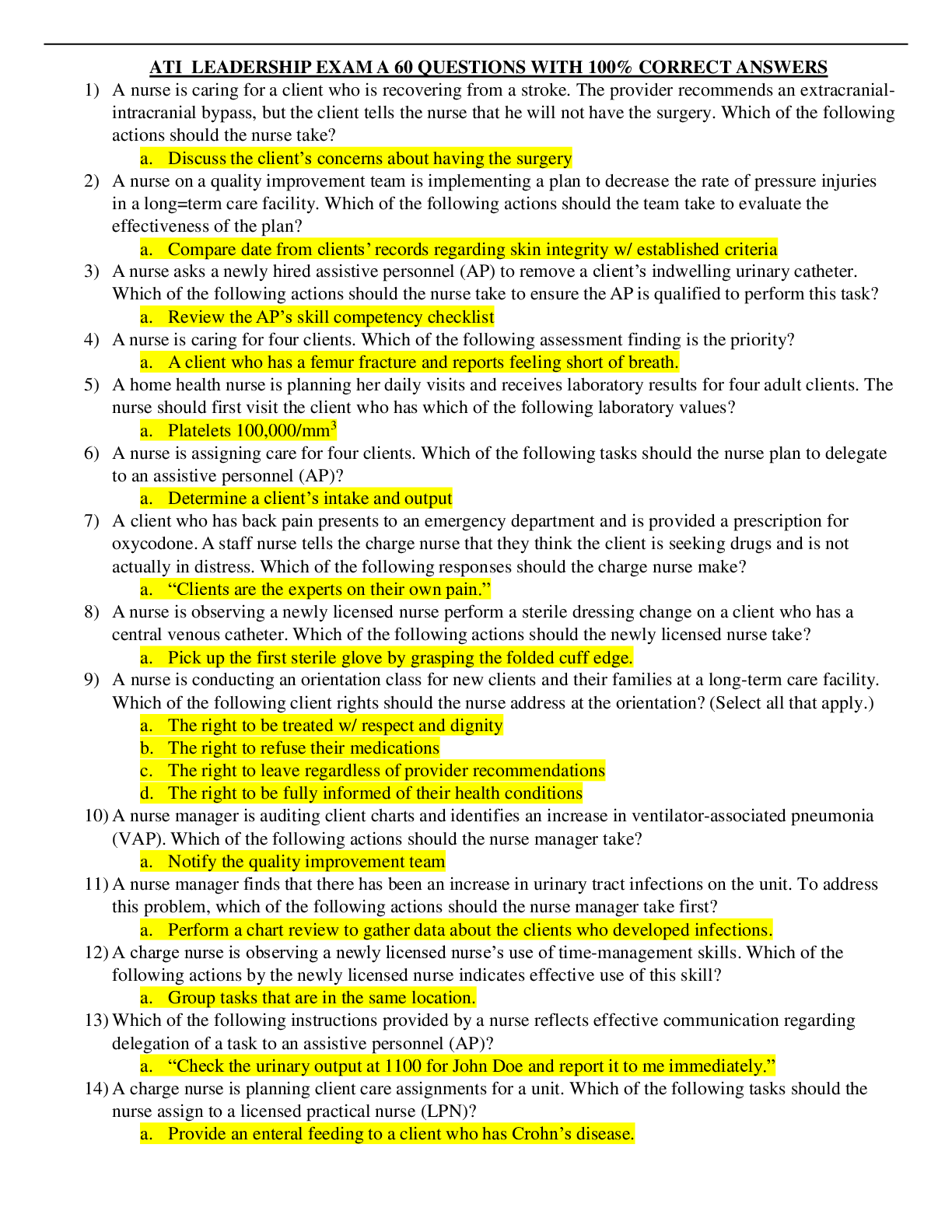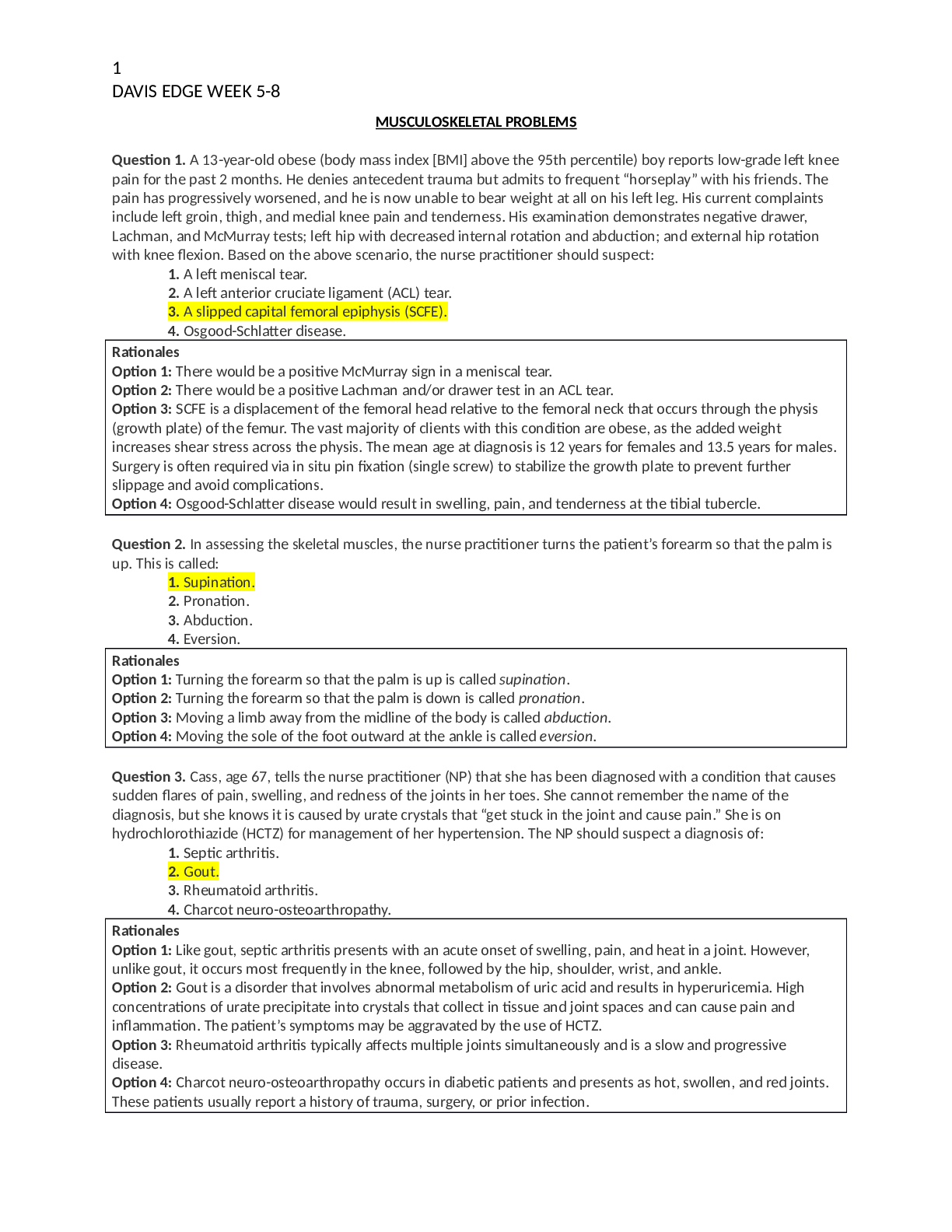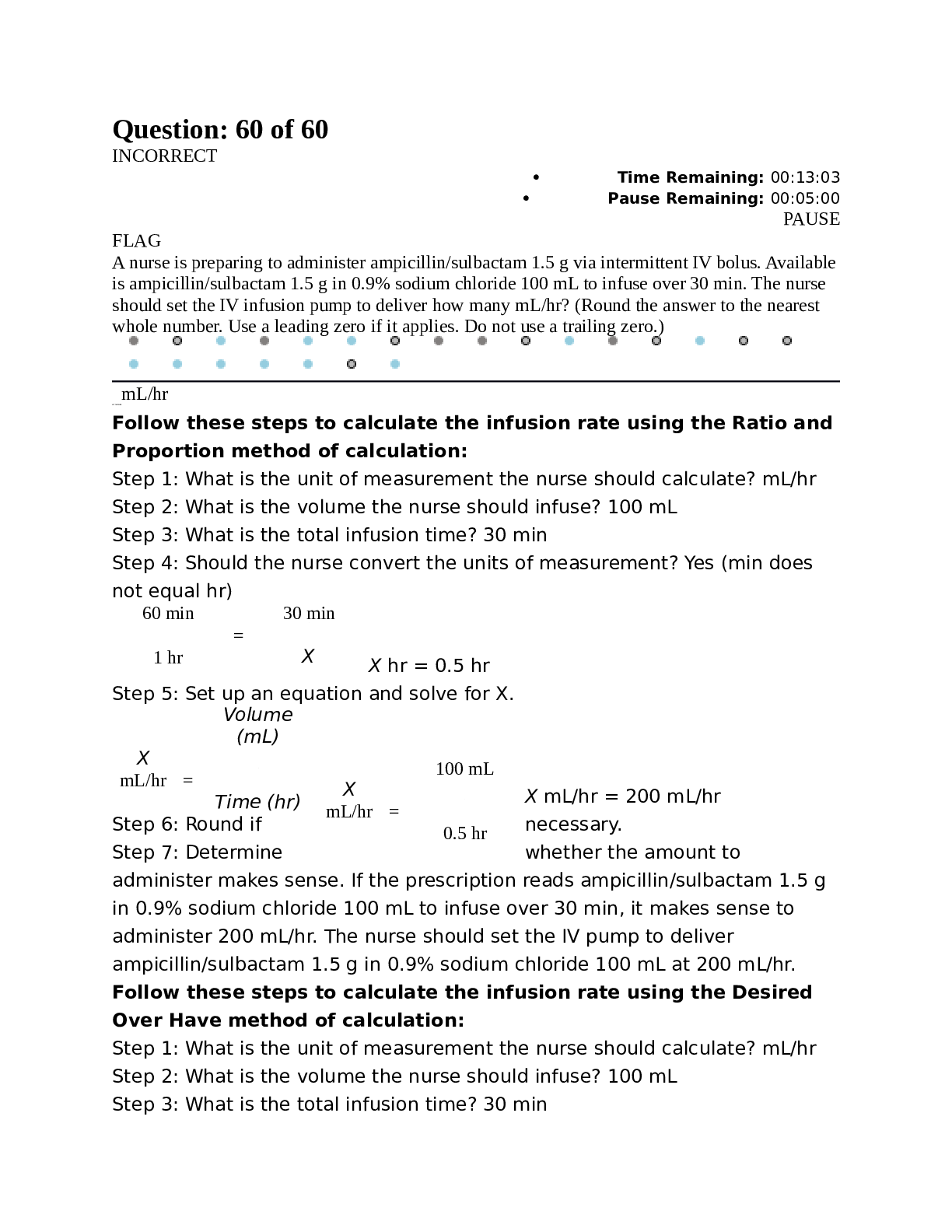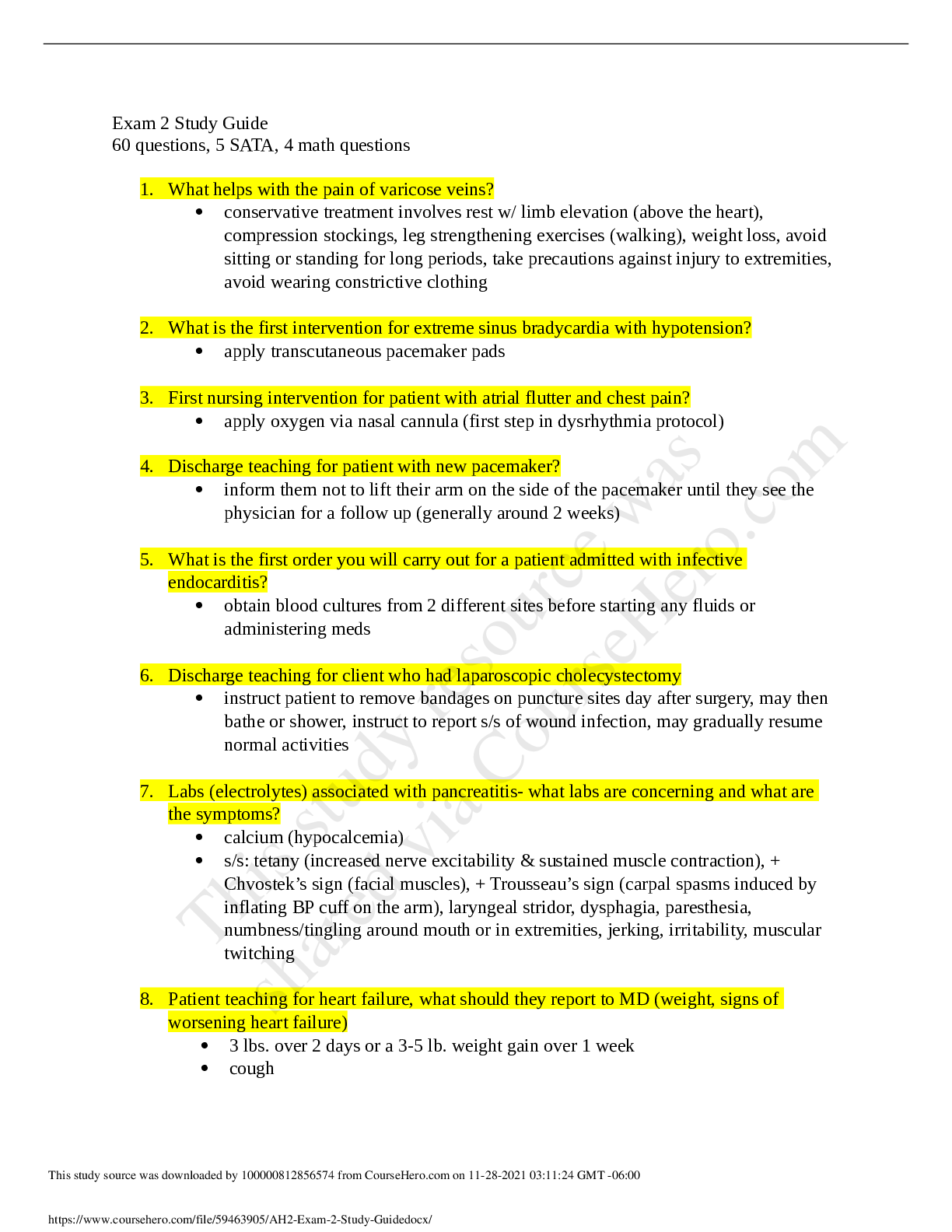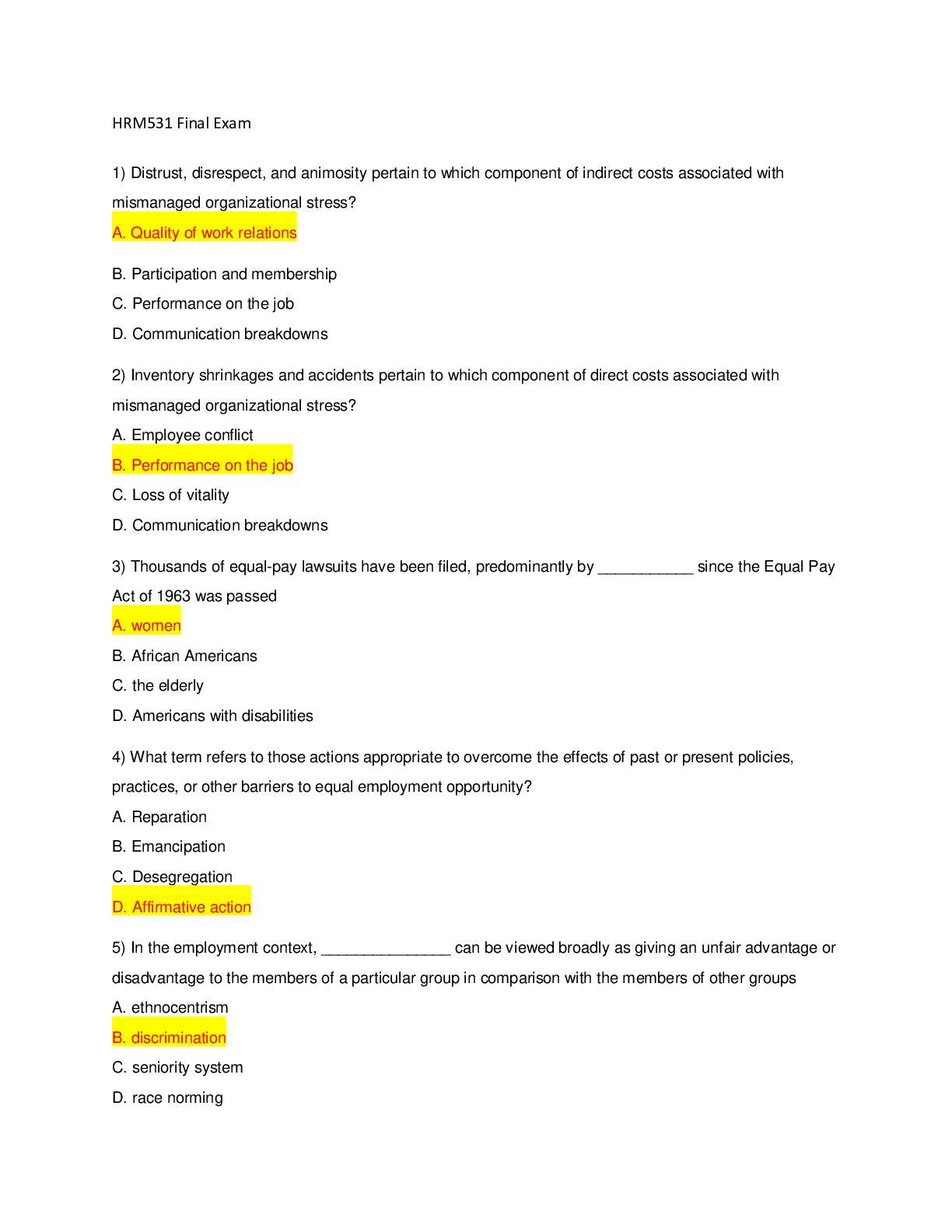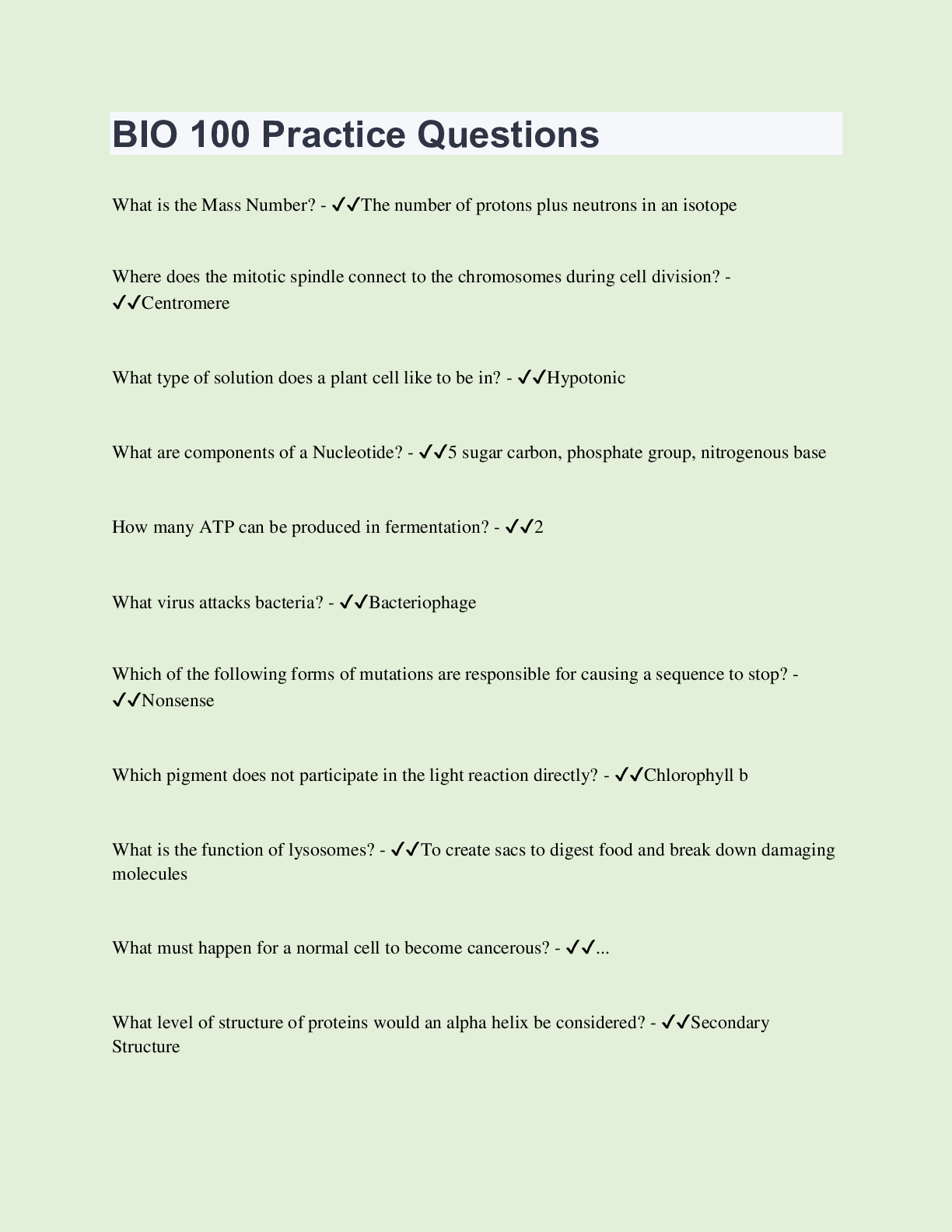*NURSING > QUESTIONS & ANSWERS > PN VATI Pharmacology Exam|Latest VATI PHARM TEST Complete 60 Questions & Answers,Already Graded A. (All)
PN VATI Pharmacology Exam|Latest VATI PHARM TEST Complete 60 Questions & Answers,Already Graded A.
Document Content and Description Below
VATI PHARM EXAM TEST PREP Question: 60 of 60 A nurse is preparing to administer ampicillin/sulbactam 1.5 g via intermittent IV bolus. Available is ampicillin/sulbactam 1.5 g in 0.9% sodium chlorid... e 100 mL to infuse over 30 min. The nurse should set the IV infusion pump to deliver how many mL/hr? (Round the answer to the nearest whole number. Use a leading zero if it applies. Do not use a trailing zero.) MY ANSWER Follow these steps to calculate the infusion rate using the Ratio and Proportion method of calculation: Step 1: What is the unit of measurement the nurse should calculate? mL/hr Step 2: What is the volume the nurse should infuse? 100 mL Step 3: What is the total infusion time? 30 min Step 4: Should the nurse convert the units of measurement? Yes (min does not equal hr) Step 6: Round if necessary. Step 7: Determine whether the amount to administer makes sense. If the prescription reads ampicillin/sulbactam 1.5 g in 0.9% sodium chloride 100 mL to infuse over 30 min, it makes sense to administer 200 mL/hr. The nurse should set the IV pump to deliver ampicillin/sulbactam 1.5 g in 0.9% sodium chloride 100 mL at 200 mL/hr. Follow these steps to calculate the infusion rate using the Desired Over Have method of calculation: Step 1: What is the unit of measurement the nurse should calculate? mL/hr Step 2: What is the volume the nurse should infuse? 100 mL Step 3: What is the total infusion time? 30 min Step 4: Should the nurse convert the units of measurement? Yes (min does not equal hr) Step 6: Round if necessary. Step 7: Determine whether the amount to administer makes sense. If the prescription reads ampicillin/sulbactam 1.5 g in 0.9% sodium chloride 100 mL to infuse over 30 min, it makes sense to administer 200 mL/hr. The nurse should set the IV pump to deliver ampicillin/sulbactam 1.5 g in 0.9% sodium chloride 100 mL at 200 mL/hr. Follow these steps to calculate the infusion rate using the Dimensional Analysis method of calculation: Step 1: What is the unit of measurement the nurse should calculate? (Place the unit of measure being calculated on the left side of the equation.) X mL/hr = Step 2: Determine the ratio that contains the same unit as the unit being calculated. (Place the ratio on the right side of the equation, ensuring that the unit in the numerator matches the unit being calculated.) Step 3: Place any remaining ratios that are relevant to the item on the right side of the equation along with any needed conversion factors to cancel out unwanted units of measurements. Step 5: Round if necessary. Step 6: Determine whether the amount to administer makes sense. If the prescription reads ampicillin/sulbactam 1.5 g in 0.9% sodium chloride 100 mL to infuse over 30 min, it makes sense to administer 200 mL/hr. The nurse should set the IV pump to deliver ampicillin/sulbactam 1.5 g in 0.9% sodium chloride 100 mL at 200 mL/hr. Question: 59 of 60 A nurse is caring for a client who is postmenopausal and has a prescription for raloxifene. The nurse should instruct the client that raloxifene is prescribed for which of the following reasons? Question: 58 of 60 A nurse is preparing to administer topotecan IV for a client who has metastatic ovarian cancer. Which of the following medications should the nurse expect to administer to control the adverse effects of topotecan? Question: 57 of 60 A nurse is providing teaching to an adolescent who has a prescription for cromolyn for the management of asthma. Which of the following statements by the adolescent indicates an understanding of the teaching? Question: 56 of 60 A nurse is reviewing the laboratory report for a client who has been taking sodium polystyrene sulfonate. Which of the following findings indicates a therapeutic response to the medication? Question: 55 of 60 A nurse is providing discharge teaching to a client who has tuberculosis and is taking rifampin. Which of the following statements by the client indicates an understanding of the teaching? Question: 54 of 60 A nurse is preparing to administer medications to a client. The client tells the nurse, "I will take the pills but not that liquid medication." Which of the following actions should the nurse take? Question: 53 of 60 A nurse is providing teaching to a client about the adverse effects of spironolactone. Which of the following adverse effects should the nurse include in the teaching? Question: 52 of 60 A nurse is teaching a newly licensed nurse about didanosine therapy. Which of the following client conditions should the nurse identify as an indication for treatment with didanosine? Question: 51 of 60 A nurse is assessing a client who has a prescription for oral albuterol for the long-term management of asthma. For which of the following adverse effects should the nurse monitor? Question: 50 of 60 A nurse is providing teaching to a client who has a history of diabetes mellitus and a new prescription for hydrochlorothiazide to treat uncontrolled hypertension. Which of the following information should the nurse include in the teaching? Question: 49 of 60 A nurse is reviewing the laboratory results for a client who is taking warfarin following orthopedic surgery. Which of the following results should the nurse report to the provider? Question: 48 of 60 A nurse is providing discharge teaching to a client who has a gastric ulcer and a new prescription for esomeprazole. Which of the following information should the nurse include in the teaching? Question: 47 of 60 A nurse is monitoring a client who is receiving warfarin and has an INR of 4. Which of the following medications should the nurse plan to administer? Question: 46 of 60 A nurse in the emergency department is planning care for a client who had a myocardial infarction and is receiving thrombolytic therapy with an IV infusion of alteplase. Which of the following interventions should the nurse include in the plan? Question: 45 of 60 A nurse is providing teaching to a client who is scheduled to receive chemotherapy and has a prescription for ondansetron to control nausea and vomiting. Which of the following information should the nurse include in the teaching? Question: 44 of 60 A nurse is caring for a client who has hydromorphone toxicity. The nurse should anticipate a prescription for which of the following medications? Question: 43 of 60 A nurse is planning care for a client who is taking tamoxifen for treatment of breast cancer. Which of the following interventions should the nurse include in the plan? (Select all that apply.) Question: 42 of 60 A nurse is reviewing the medication list of a client who has a new prescription for clopidogrel after undergoing coronary artery stenting. Which of the following findings should the nurse report to the provider? Question: 41 of 60 A nurse is caring for a client who is taking pseudoephedrine orally to treat allergic rhinitis. The nurse should assess for which of the following potential adverse effects of this medication? Question: 40 of 60 A nurse is caring for a client who is postoperative following orthopedic surgery and is receiving IV ketorolac. Which of the following findings should the nurse identify as the priority to report to the provider? Question: 39 of 60 A nurse is caring for a client who ingested a toxic amount of acetaminophen 36 hr ago. For which of the following findings should the nurse monitor? (Select all that apply.) Question: 38 of 60 A nurse is administering haloperidol to a client who has schizophrenia. For which of the following adverse effects should the nurse monitor? Question: 37 of 60 A nurse is caring for a client who reports an increase in migraine headaches over the past 2 weeks and asks if sumatriptan might be helpful. Which of the following conditions from the client's medical history should the nurse recognize as a contraindication for this medication? Question: 36 of 60 A nurse receives a verbal prescription from the provider for hydrochlorothiazide 25 mg by mouth daily for a client who has hypertension. Which of the following indicates how the nurse should transcribe the prescription in the client's medical record? Question: 35 of 60 PAUSE A nurse is caring for a client who has a prescription for penicillin V. Which of the following adverse effects is the priority for the nurse to monitor after the administration of the medication? Question: 34 of 60 A nurse is providing teaching to a client who has gout and a new prescription for allopurinol. Which of the following statements should the nurse make to explain how this medication will help relieve the client's manifestations? Question: 33 of 60 A nurse is planning care for a child who has a prescription for somatropin. Which of the following interventions should the nurse include to evaluate the therapeutic effect of this medication? Question: 32 of 60 A nurse is preparing to administer verapamil 0.1 mg/kg via intermittent IV bolus over 2 min. Available is verapamil 2.5 mg/mL. The client weighs 165 lb. How many mL should the nurse administer? (Round the answer to the nearest whole number. Use a leading zero if it applies. Do not use a trailing zero.) MY ANSWER Follow these steps for the Ratio and Proportion method of calculation: Step 1: What is the unit of measurement the nurse should calculate? kg Step 2: Set up an equation and solve for X. Step 3: What is the unit of measurement the nurse should calculate? mg Step 4: Set up an equation and solve for X. Step 5: What is the unit of measurement the nurse should calculate? mL Step 6: What is the dose the nurse should administer? Dose to administer = Desired 7.5 mg Step 7: What is the dose available? Dose available = Have 2.5 mg Step 8: Should the nurse convert the units of measurement? No Step 9: What is the quantity of the dose available? 1 mL Step 10: Set up an equation and solve for X. Step 11: Round if necessary. Step 12: Determine whether the amount to administer makes sense. If there are 2.5 mg/mL and the prescription reads 0.1 mg/kg, it makes sense to administer 3 mL. The nurse should administer verapamil 3 mL via intermittent IV bolus. Follow these steps for the Desired Over Have method of calculation: Step 1: What is the unit of measurement the nurse should calculate? kg Step 2: Set up an equation and solve for X. Step 3: What is the unit of measurement the nurse should calculate? mg Step 4: Set up an equation and solve for X. X = Dose per kg × Client's weight in kg X mg = 0.1 mg/kg × 75 kg X mg = 7.5 mg Step 5: What is the unit of measurement the nurse should calculate? mL Step 6: What is the dose the nurse should administer? Dose to administer = Desired 7.5 mg Step 7: What is the dose available? Dose available = Have 2.5 mg Step 8: Should the nurse convert the units of measurement? No Step 9: What is the quantity of the dose available? 1 mL Step 10: Set up an equation and solve for X. Step 11: Round if necessary. Step 12: Determine whether the amount to administer makes sense. If there are 2.5 mg/mL and the prescription reads 0.1 mg/kg, it makes sense to administer 3 mL. The nurse should administer verapamil 3 mL via intermittent IV bolus. Follow these steps for the Dimensional Analysis method of calculation: Step 1: What is the unit of measurement the nurse should calculate? (Place the unit of measure being calculated on the left side of the equation.) Step 2: Determine the ratio that contains the same unit as the unit being calculated. (Place the ratio on the right side of the equation, ensuring that the unit in the numerator matches the unit being calculated.) Step 3: Place any remaining ratios that are relevant to the item on the right side of the equation, along with any needed conversion factors, to cancel out unwanted units of measurement. Step 5: Round if necessary. Step 6: Determine whether the amount to administer makes sense. If there are 2.5 mg/mL and the prescription reads 0.1 mg/kg, it makes sense to administer 3 mL. The nurse should administer verapamil 3 mL via intermittent IV bolus. Question: 31 of 60 A nurse is caring for a client who is receiving heparin by continuous IV infusion for treatment of venous thrombosis. Which of the following laboratory values should the nurse monitor for in order to titrate the heparin dose? Question: 29 of 60 A nurse is caring for a client who has a ventricular dysrhythmia and a new prescription for amiodarone. Which of the following interventions should the nurse include in the client's plan of care? Question: 28 of 60 A nurse is preparing to administer morphine 0.3 mg/kg PO to a school-age child who weighs 88 lb. Available is morphine oral solution 2 mg/mL. How many mL should the nurse administer? (Round the answer to the nearest whole number. Use a leading zero if it applies. Do not use a trailing zero.) MY ANSWER Follow these steps for the Ratio and Proportion method of calculation: Step 1: What is the unit of measurement the nurse should calculate? kg Step 2: Set up an equation and solve for X. Step 3: What is the unit of measurement the nurse should calculate? mg Step 4: Set up an equation and solve for X. Step 5: What is the unit of measurement the nurse should calculate? mL Step 6: What is the dose the nurse should administer? Dose to administer = Desired 12 mg Step 7: What is the dose available? Dose available = Have 2 mg Step 8: Should the nurse convert the units of measurement? No Step 9: What is the quantity of the dose available? 1 mL Step 10: Set up an equation and solve for X. Step 11: Round if necessary. Step 12: Determine whether the amount to administer makes sense. If there are 2 mg/mL and the prescription reads 0.3 mg/kg, it makes sense to administer 6 mL. The nurse should administer morphine 6 mL. Follow these steps for the Desired Over Have method of calculation: Step 1: What is the unit of measurement the nurse should calculate? kg Step 2: Set up an equation and solve for X. Step 3: What is the unit of measurement the nurse should calculate? mg Step 4: Set up an equation and solve for X. X = Dose per kg × Client's weight in kg X mg = 0.3 mg/kg × 40 kg X mg = 12 mg Step 5: What is the unit of measurement the nurse should calculate? mL Step 6: What is the dose the nurse should administer? Dose to administer = Desired 12 mg Step 7: What is the dose available? Dose available = Have 2 mg Step 8: Should the nurse convert the units of measurement? No Step 9: What is the quantity of the dose available? 1 mL Step 10: Set up an equation and solve for X. X = ________________________________________ Have Step 11: Round if necessary. Step 12: Determine whether the amount to administer makes sense. If there are 2 mg/mL and the prescription reads 0.3 mg/kg, it makes sense to administer 6 mL. The nurse should administer morphine 6 mL. Follow these steps for the Dimensional Analysis method of calculation: Step 1: What is the unit of measurement the nurse should calculate? (Place the unit of measure being calculated on the left side of the equation.) X mL = Step 2: Determine the ratio that contains the same unit as the unit being calculated. (Place the ratio on the right side of the equation, ensuring that the unit in the numerator matches the unit being calculated.) Step 3: Place any remaining ratios that are relevant to the item on the right side of the equation, along with any needed conversion factors, to cancel out unwanted units of measurement. Question: 27 of 60 A nurse is assessing a client who has a positive Trousseau's sign. Which of the following medications should the nurse plan to administer? Question: 26 of 60 A nurse is assessing a client who is taking ethinyl estradiol and norethindrone for contraception. Which of the following manifestations should the nurse identify as a potential adverse effect of this medication combination? Question: 24 of 60 A nurse is reviewing the medical history of a client who has a new diagnosis of diabetes mellitus and is asking about taking metformin. Which of the following client conditions should the nurse identify as a contraindication for this medication? Question: 23 of 60 IN A nurse is teaching a client who has a diagnoses of heart failure about furosemide. Which of the following instructions should the nurse include in the teaching about this medication? (Select all that apply.) Question: 22 of 60 A nurse is assessing a client who is receiving androgen therapy to treat endometriosis. The nurse should monitor the client for which of the following adverse effects? Question: 21 of 60 A nurse is providing teaching to a client who has a new prescription for ciprofloxacin. Which of the following adverse effects should the nurse include in the teaching? Question: 20 of 60 A nurse is caring for a client who is taking lovastatin and has a new prescription for ezetimibe to lower cholesterol levels. Which of the following laboratory values should the nurse monitor? Question: 19 of 60 A nurse is providing teaching to a client who has new prescriptions for beclomethasone and albuterol inhalers. Which of the following instructions should the nurse include in the teaching? Question: 18 of 60 A nurse is caring for a client who is receiving meperidine. Which of the following is the nurse's priority assessment before administering the medication? Question: 17 of 60 A nurse is preparing to administer mannitol via continuous IV infusion to a client. Which of the following findings should the nurse identify as an expected outcome of this medication therapy? Question: 16 of 60 A nurse is administering medications to a client and realizes the client received clonidine rather than the prescribed clonazepam. After checking the client's blood pressure, which of the following actions should the nurse take first? . The nurse should ensure that the client receives the medication. However, there is another action the nurse should take first. Question: 15 of 60 A nurse in the emergency department is caring for a client who accidentally doubled their last dose of diazepam. After assessing the client, which of the following medications should the nurse plan to administer? Question: 14 of 60 A nurse is preparing to administer diclofenac to a client who has chronic bursitis. Which of the following actions should the nurse take? Question: 13 of 60 A nurse is caring for a client who is receiving midazolam during a colonoscopy. The client's blood pressure decreases from 122/84 mm Hg to 86/50 mm Hg. Which of the following medications should the nurse expect the provider to prescribe for the client? Question: 12 of 60 A nurse is reviewing the medical record of a client who is taking epoetin alfa. Which of the following laboratory tests should the nurse monitor to determine the effectiveness of the medication? (Select all that apply.) Question: 11 of 60 A nurse is caring for a client who has a prescription for acyclovir IV three times daily. Which of the following actions should the nurse take? Question: 10 of 60 A nurse is planning care for a client who has a prescription for acetazolamide. Which of the following findings should the nurse plan to monitor for as an adverse effect of this medication? Question: 9 of 60 A nurse is assessing a client prior to administration of atenolol and finds that the client's apical heart rate is 61/min. Which of the following actions should the nurse take? Question: 8 of 60 IN A nurse is planning care for a client who has asthma and a prescription for methylprednisolone. Which of the following laboratory values should the nurse monitor while the client is receiving this medication? Question: 7 of 60 A nurse is providing teaching to a client about proper administration of a medication with regard to meals. The nurse should instruct the client that the presence of food will alter the rate of which of the following pharmacokinetic processes? Question: 6 of 60 A nurse on a telemetry unit is caring for a client who has a new prescription for digoxin. The nurse should identify that which of the following cardiac rhythms is a contraindication for administration of the medication? The QRS complex represents ventricular depolarization. Narrow QRS complexes appear with tachycardia and are not a contraindication for digoxin therapy. Question: 5 of 60 A nurse is assessing a client who has ovarian cancer and is receiving paclitaxel. Which of the following findings is the priority for the nurse to report to the provider? Question: 4 of 60 IN A nurse is preparing to administer enoxaparin 40 mg subcutaneously. Available is a prefilled syringe containing 100 mg/mL. How many mL should the nurse discard from the syringe to administer the prescribed amount to the client? (Round the answer to the nearest tenth. Use a leading zero if it applies. Do not use a trailing zero.) MY ANSWER Follow these steps for the Ratio and Proportion method of calculation: Step 1: What is the unit of measurement the nurse should calculate? mL Step 2: What is the dose the nurse should administer? Dose to administer = Desired 40 mg Step 3: What is the dose available? Dose available = Have 100 mg Step 4: Should the nurse convert the units of measurement? No Step 5: What is the quantity of the dose available? 1 mL Step 6: Set up an equation and solve for X. Have Desired ________________________________________ = ________________________________________ Quantity X Step 7: Round if necessary. Step 8: Determine whether the amount to administer makes sense. If there are 100 mg/mL and the prescription reads 40 mg, it makes sense to administer 0.4 mL. The nurse should discard 0.6 mL (1 mL - 0.4 mL = 0.6 mL) and administer enoxaparin 0.4 mL. Follow these steps for the Desired Over Have method of calculation: Step 1: What is the unit of measurement the nurse should calculate? mL Step 2: What is the dose the nurse should administer? Dose to administer = Desired 40 mg Step 3: What is the dose available? Dose available = Have 100 mg Step 4: Should the nurse convert the units of measurement? No Step 5: What is the quantity of the dose available? 1 mL Step 6: Set up an equation and solve for X. Question: 3 of 60 A nurse is assessing a client who has Parkinson's disease and is taking levodopa/carbidopa. The nurse observes that the client has tremors and twitching. Which of the following medications should the nurse anticipate administering? Question: 2 of 60 A nurse is caring for a client who has a new prescription for an ipratropium inhaler to control COPD bronchospasm. For which of the following adverse effects should the nurse monitor? Question: 1 of 60 A nurse accidently removes celecoxib from an automated medication dispensing system (AMDS) instead of citalopram and almost administers the wrong medication to a client. Which of the following actions should the nurse take? [Show More]
Last updated: 1 year ago
Preview 1 out of 58 pages
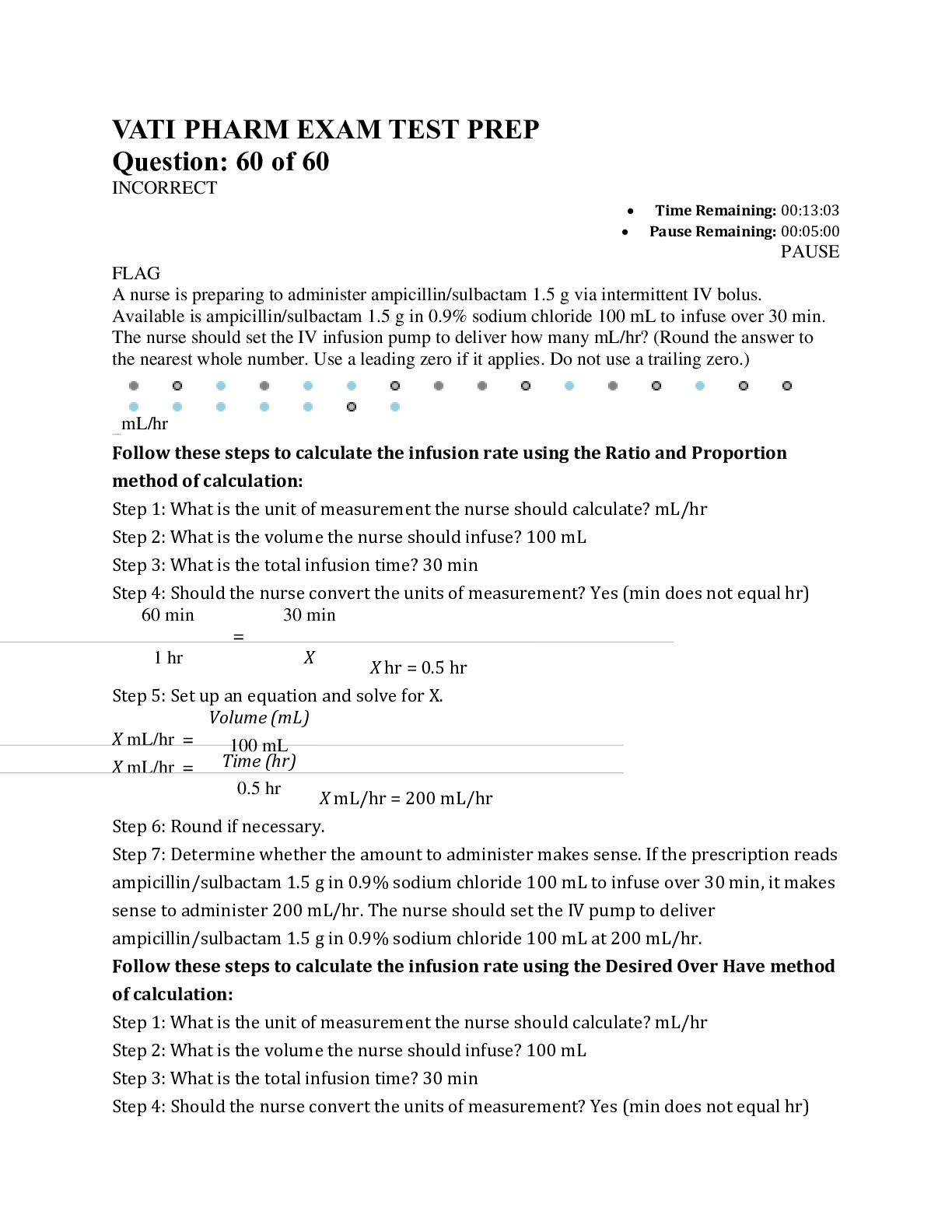
Reviews( 0 )
Document information
Connected school, study & course
About the document
Uploaded On
Jun 12, 2020
Number of pages
58
Written in
Additional information
This document has been written for:
Uploaded
Jun 12, 2020
Downloads
8
Views
982




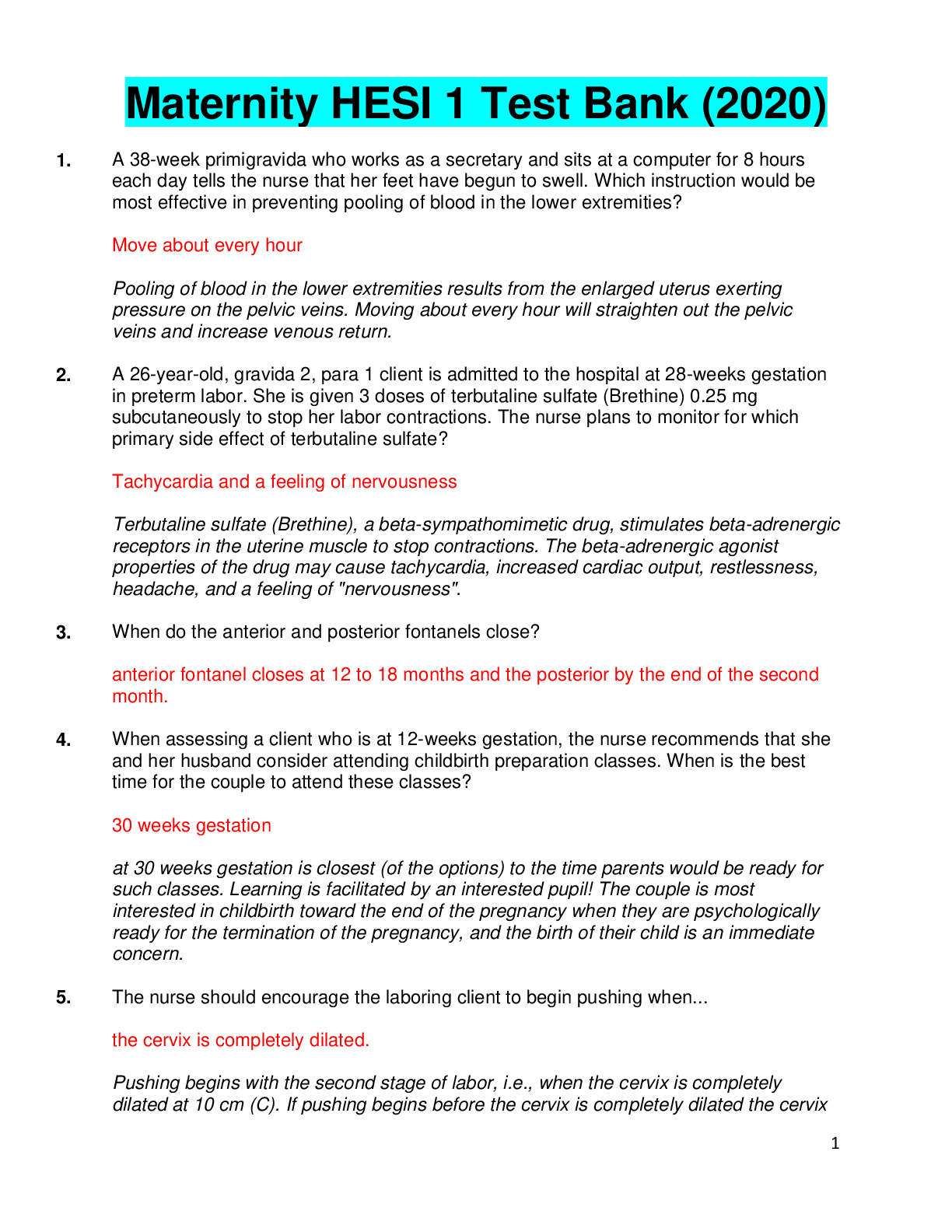

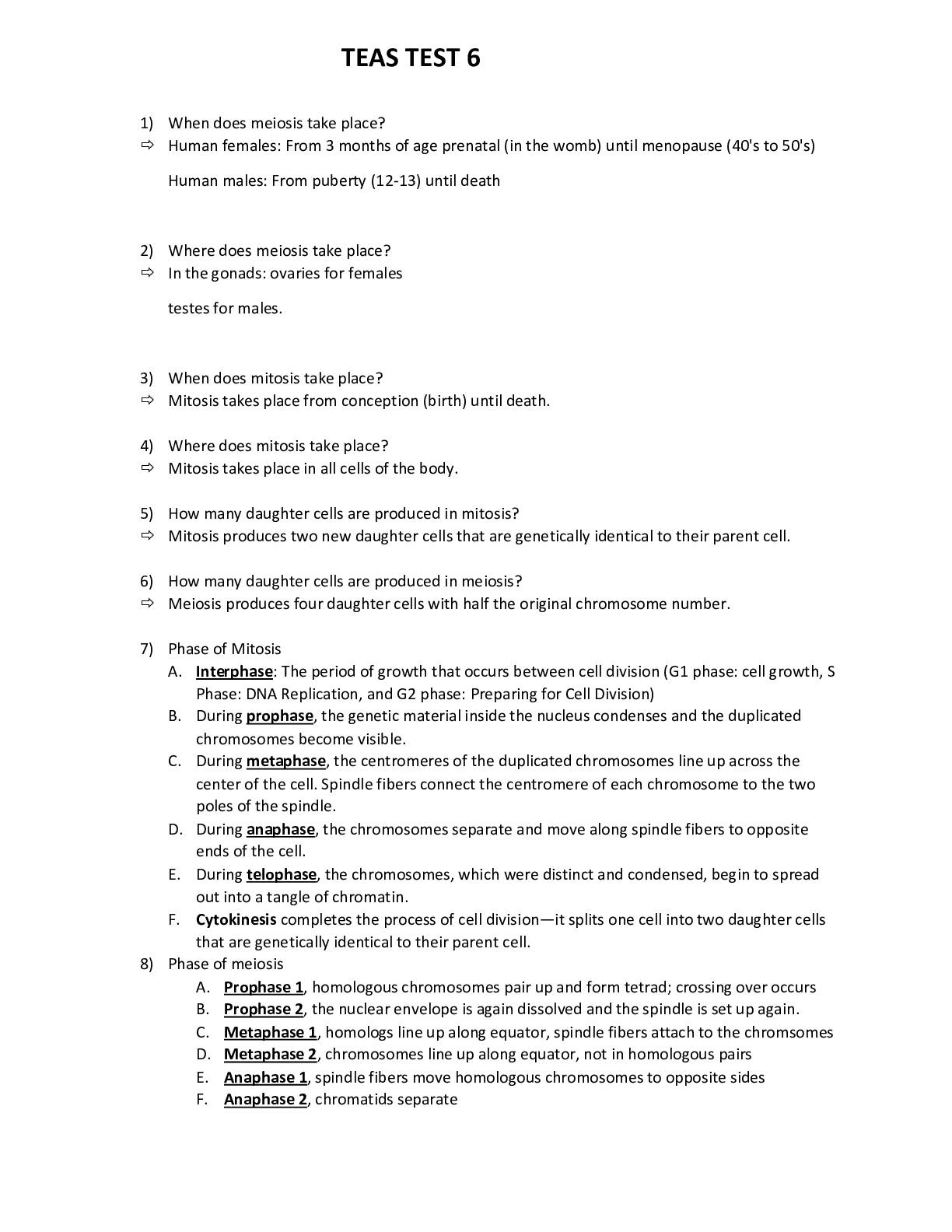
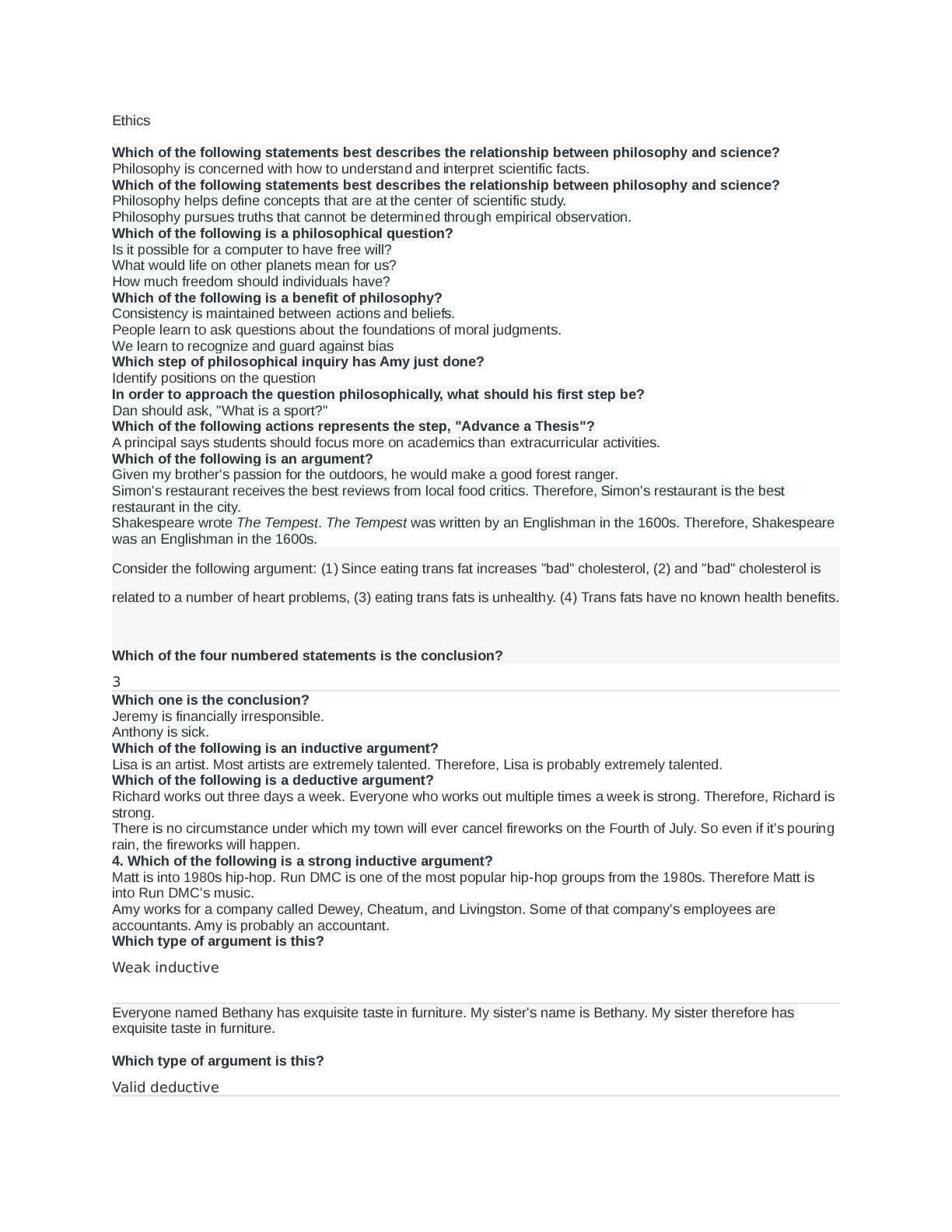


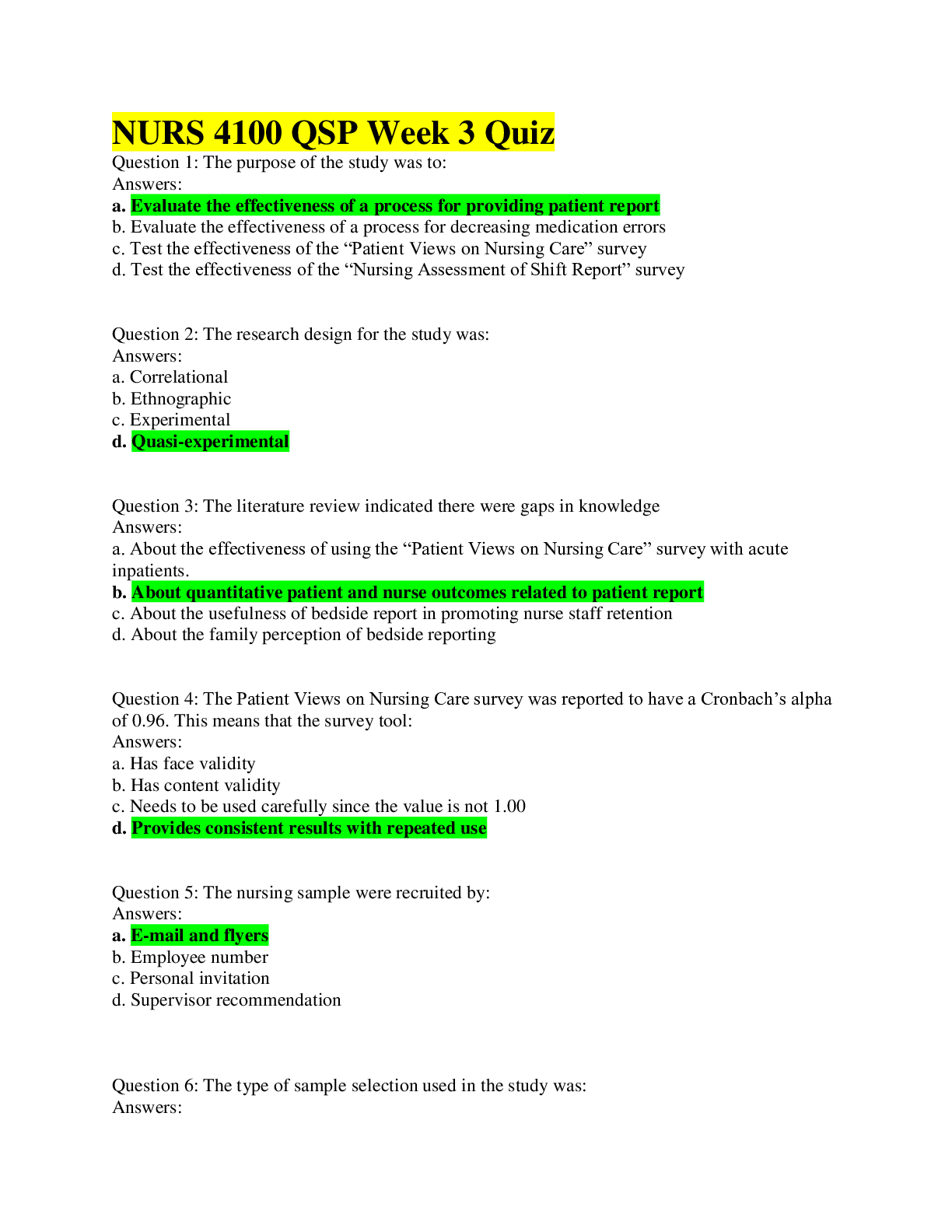
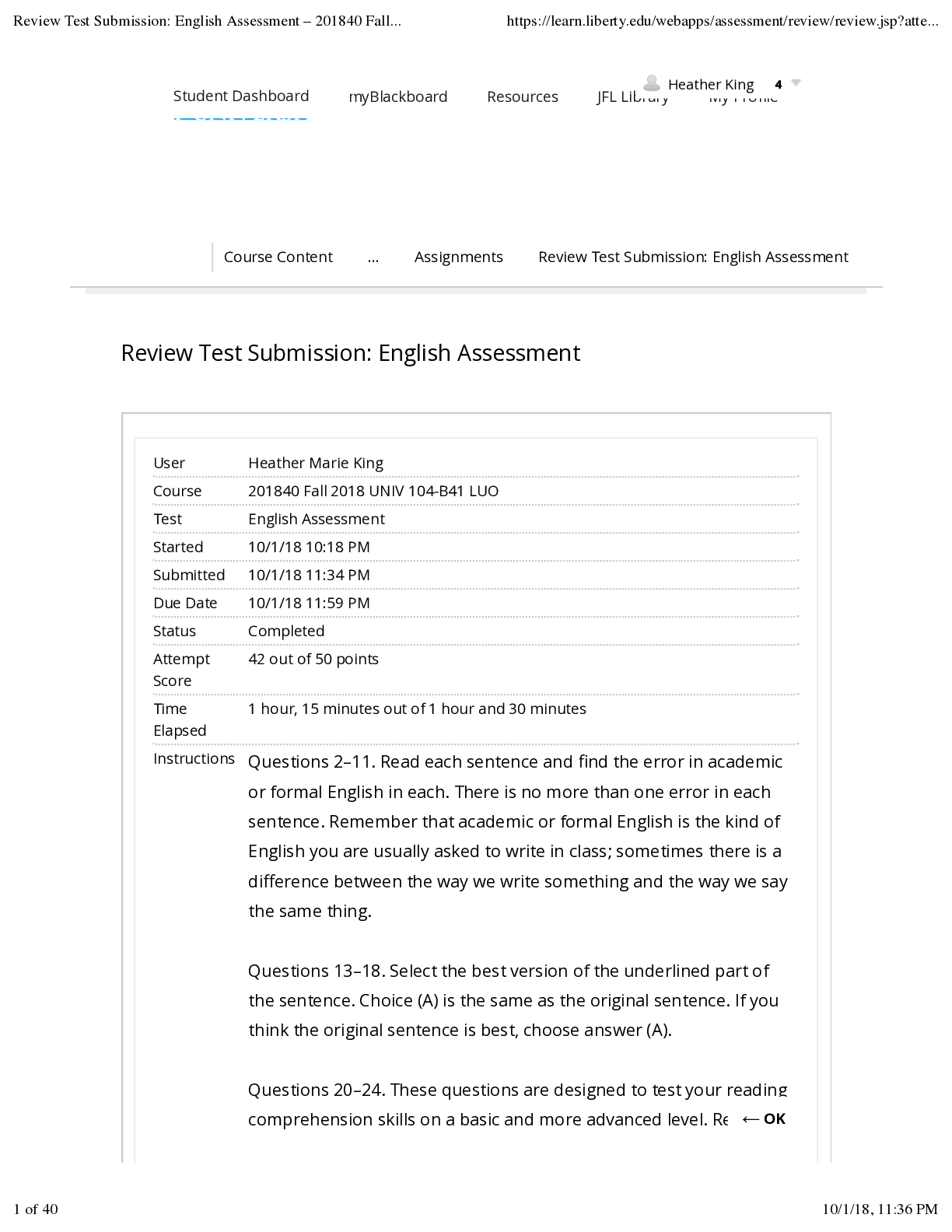

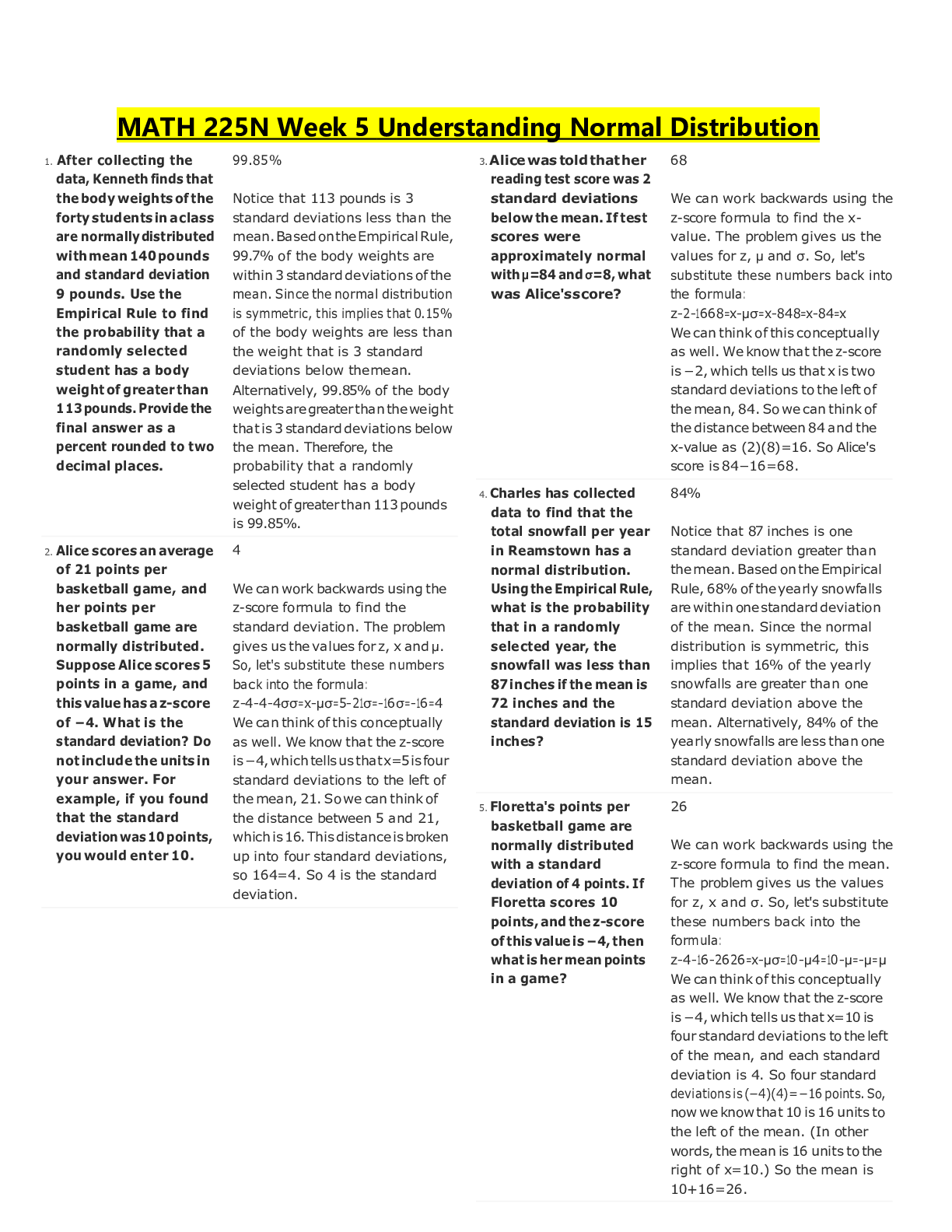
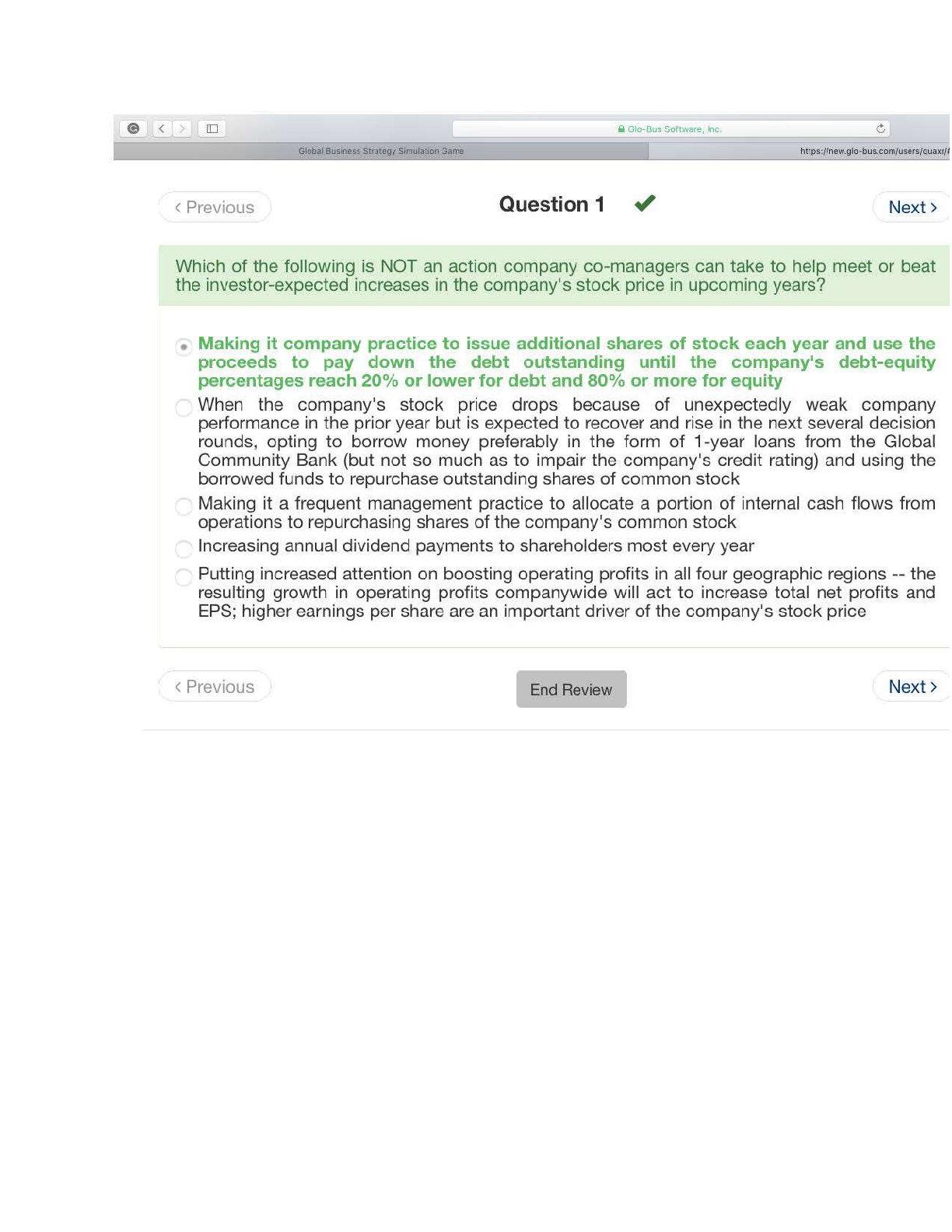
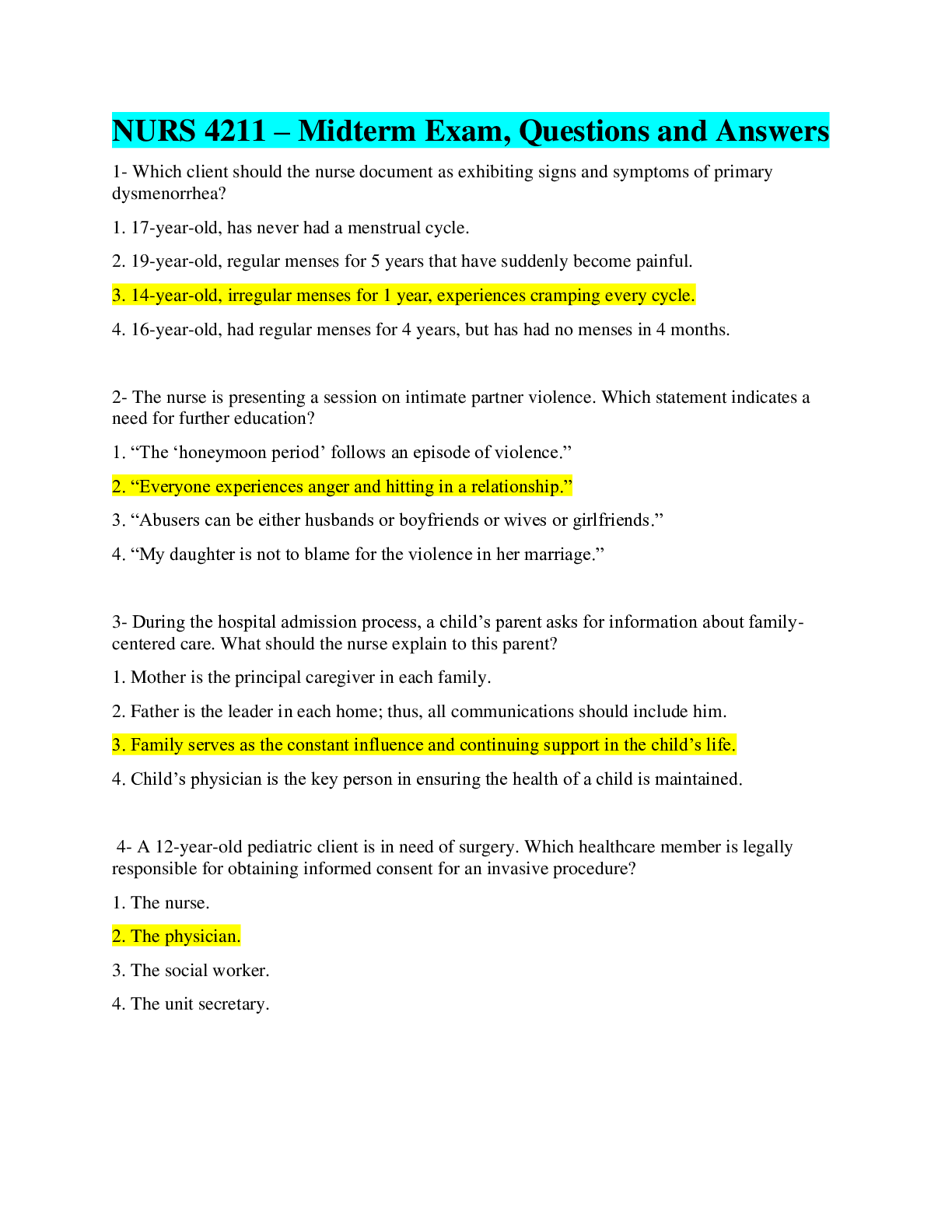

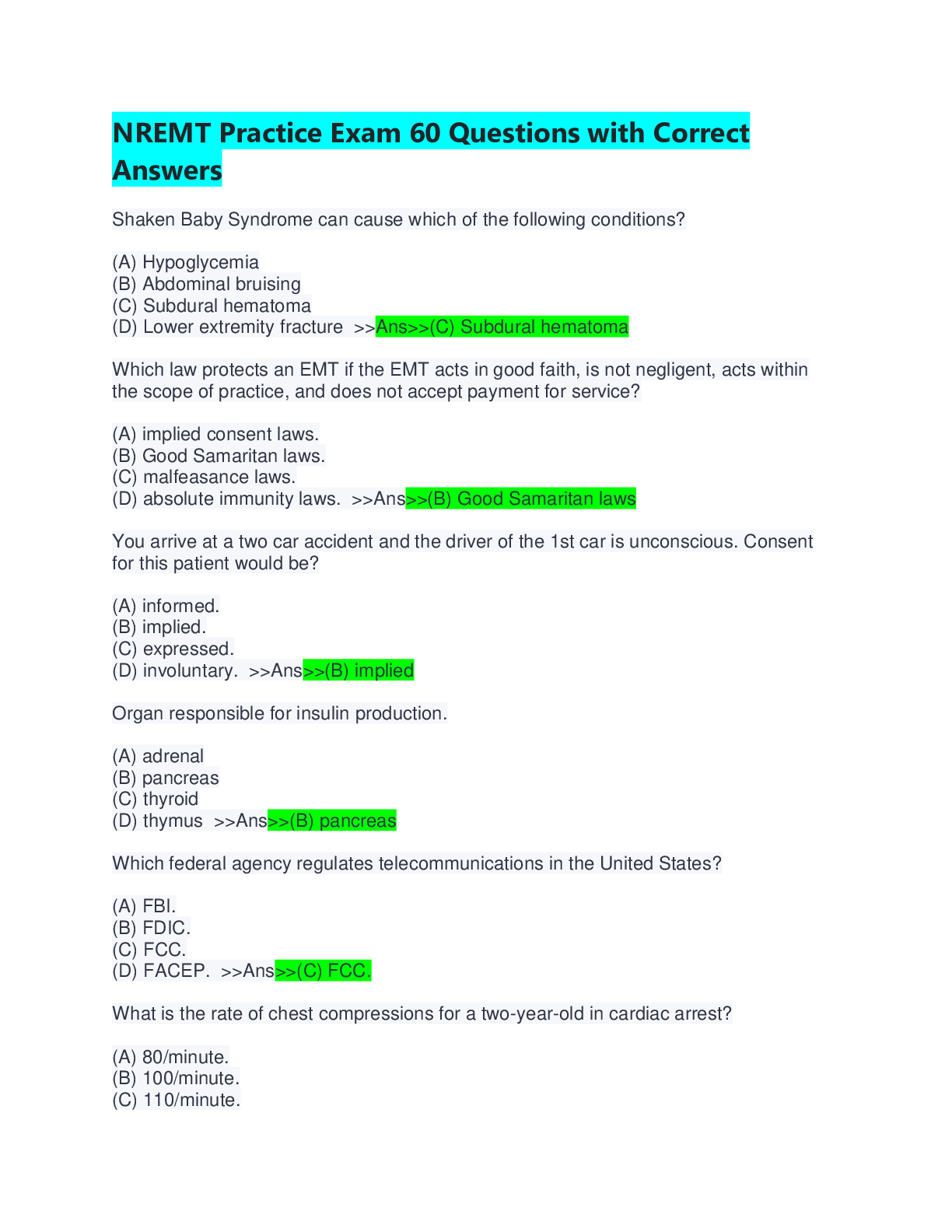
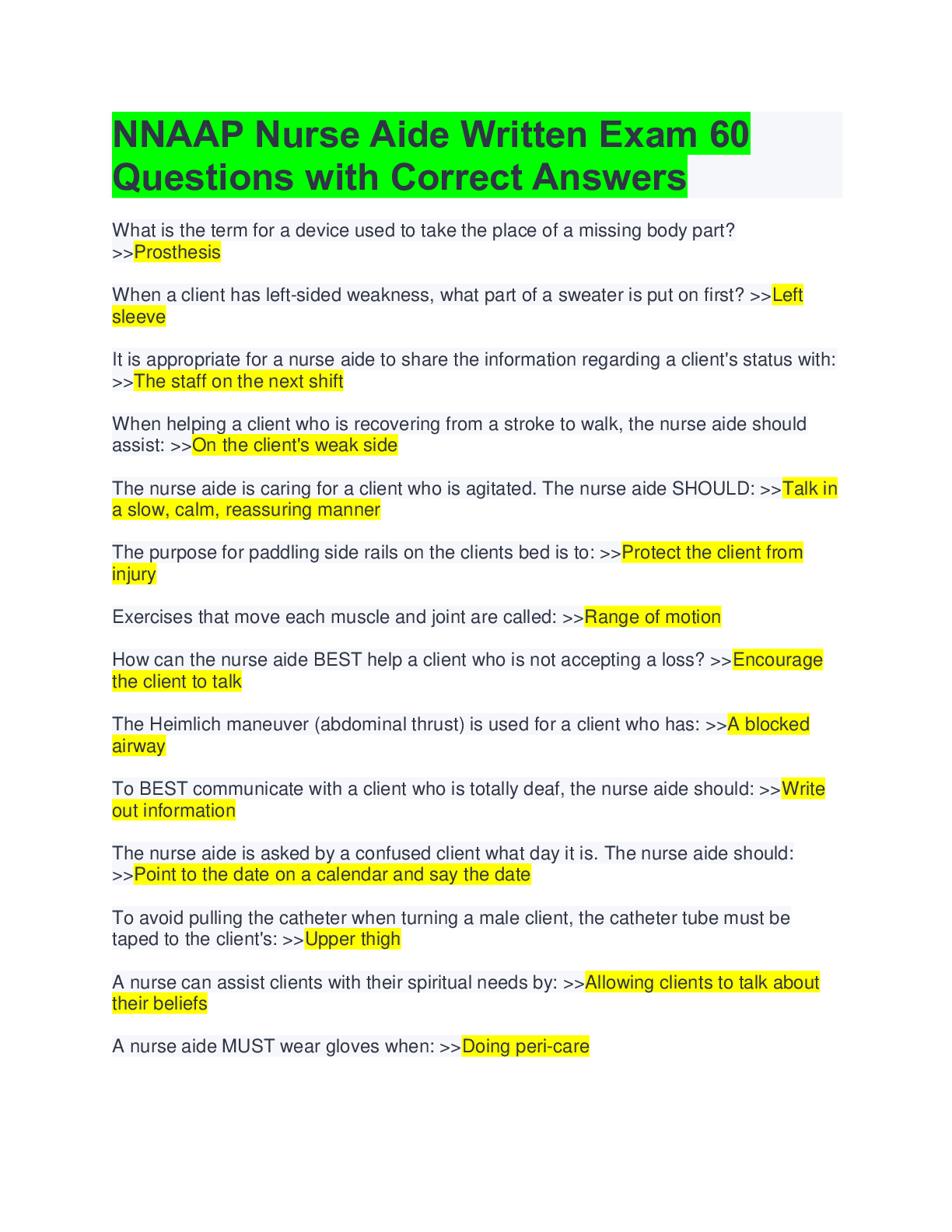
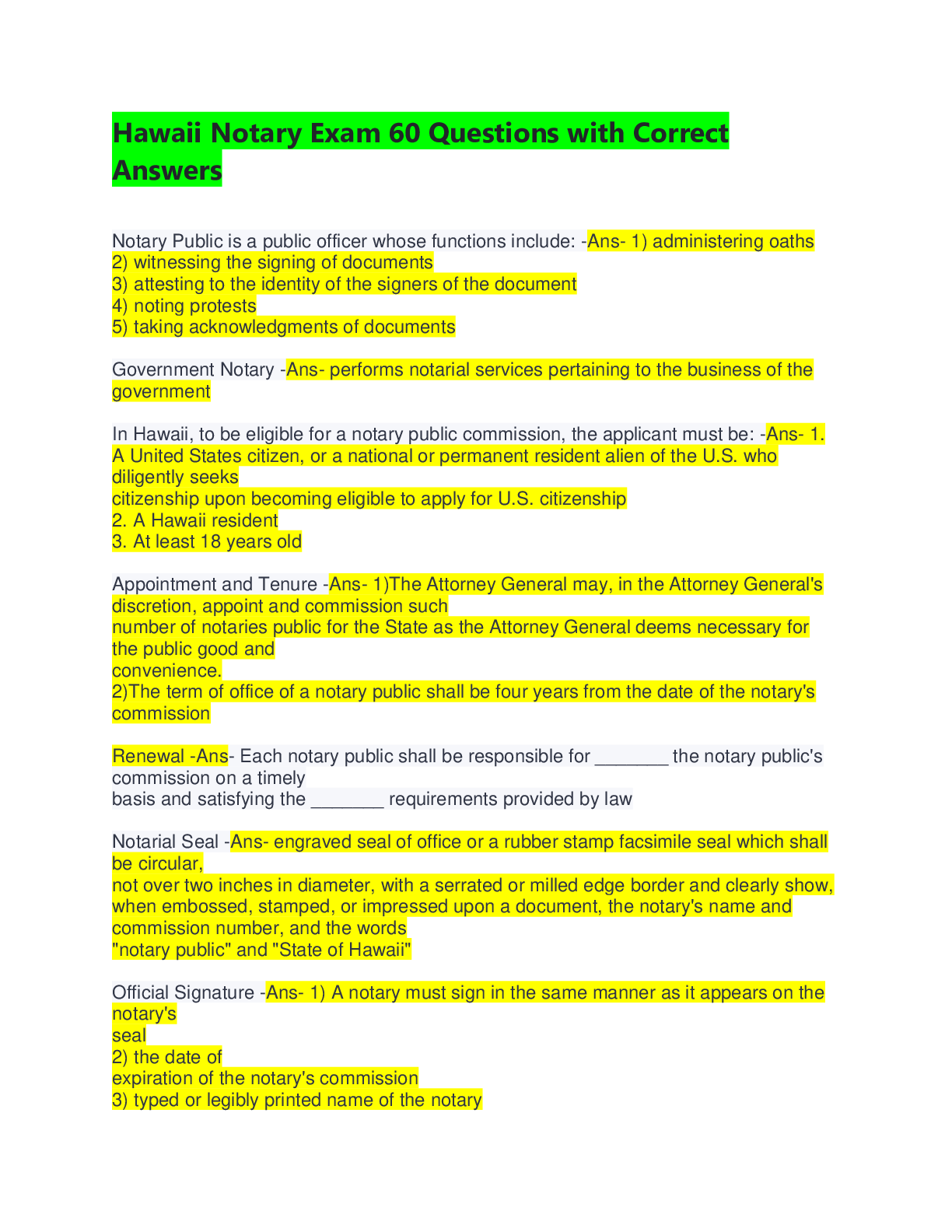


.png)
